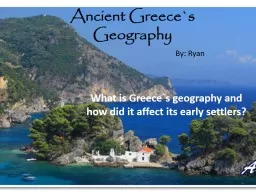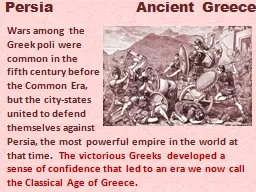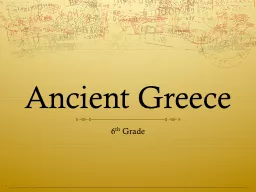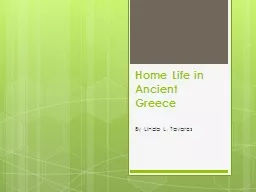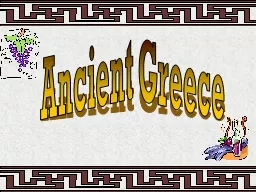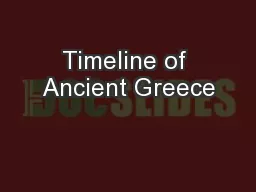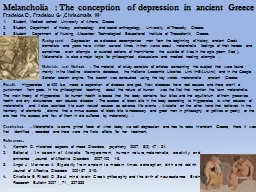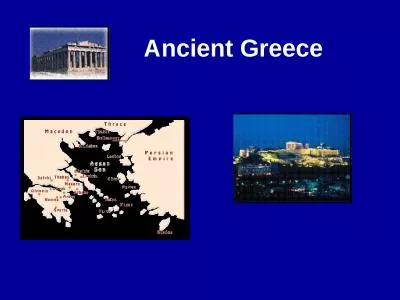PPT-Ancient Greece`s Geography
Author : debby-jeon | Published Date : 2017-03-18
What is Greeces geography and how did it affect its early settlers By Ryan Mainland Greece Mainland Greece has many mountains some coastal plains and valleys The
Presentation Embed Code
Download Presentation
Download Presentation The PPT/PDF document "Ancient Greece`s Geography" is the property of its rightful owner. Permission is granted to download and print the materials on this website for personal, non-commercial use only, and to display it on your personal computer provided you do not modify the materials and that you retain all copyright notices contained in the materials. By downloading content from our website, you accept the terms of this agreement.
Ancient Greece`s Geography: Transcript
What is Greeces geography and how did it affect its early settlers By Ryan Mainland Greece Mainland Greece has many mountains some coastal plains and valleys The mountain ranges include the Olympic Mountains Pindus Mountains and the Pelion Mountains Mainland Greece is also home to Greeces tallest mountain Mount Olympus which stands at 7979 feet above sea level Most of Greeces regions made it difficult for growing crops because of the lack of water and poor soil. Modern ideas about democracy first developed in ancient Athens. . Athenian Democracy Ancient Greece. Athens is the capital and largest city in modern Greece, but Athens also has a long history that dates back 7000 years. . Alexander the Great was a young general who amassed the largest empire of the ancient world in just thirteen years. . His career was brief because he died a young man, . but Alexander’s . legacy was a . Wars among the . Greek . poli. were . common in the . fifth century before . the Common Era, . but the city-states . united to defend . themselves against . Persia, the most powerful empire in the world at that time. . 6. th. Grade. Government. The government that we have in the United States was influenced by the democratic government that was formed in . Athens. around 500 B.C. . The . Greeks invented the idea of citizenship. They are the forefathers of many modern democracies.. Station 1. The Gods and Myths. What . are the purposes of myths in Greek culture. ?. Myths were used to explain the world around them.. . 2. Why . is the story of Prometheus an example of a myth. ?. By Linda L. Tavares. Homes. Most homes in ancient Greece had a courtyard, which was the center of activity. Children could safely play outside in the warm climate. Homes were divided into areas for the men and areas for the women. The . Wars INTRO:. Essential Standards. 6.C&G.1 . Understand the development of government in various civilizations, societies and regions.. 6.C&G.1.1 Explain the origins and structures of various governmental systems (e.g., democracy, absolute monarchy and constitutional monarchy).. isthmus. harbor. A small strip of land, with. water on both sides, that. connects two larger areas of. land.. A sheltered place with deep. water close to shore.. trireme. A large fighting ship used by. Aegean. Cultures. Geography. The Aegean Cultures are found in the area of the Aegean Sea.. The terrain is . rocky. with a huge dependency on the . water. .. Aegean Cultures. Cycladic. Culture. Existed around 2500-2000 B.C.E.. 1) The Ancient Athenians are credited with: . Inventing and using the wheel . Eliminating slavery . Establishing a democratic government . Inventing the printing press . 2) The ancient Greek city-state of Sparta: . As you look through the notes, fill in the important events for each date on your timeline. . 776 BC. Discus Throw (painted on pottery). Crown of Olive Leaves. The year of the 1st Olympic games. 776 BCE. Fradelos. E. 1. , . Fradelou. G. 2. ,. Chrisomalis. . M. 3. Student. , Medical school ,University of Athens, . Greece. Student. , Department of history ,archaeology and social anthropology, University of . There were "staff cant notation" with four lines, similar to our staff lines today. . The Music in Ancient Greece was written differently than today.. 1. . Early Civilizations. : Minoans (Crete) and Mycenae (mi se ne) . 2. . Classical Greece. (flourishing of arts, literature, philosophy; domination by Sparta and Athens) . 3. . Hellenistic Age: .
Download Rules Of Document
"Ancient Greece`s Geography"The content belongs to its owner. You may download and print it for personal use, without modification, and keep all copyright notices. By downloading, you agree to these terms.
Related Documents

